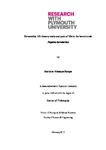Personality, life-history traits and pace of life in the hermit crab Pagurus bernhardus
| dc.contributor.supervisor | Briffa, Mark | |
| dc.contributor.author | Velasque Borges, Mariana | |
| dc.contributor.other | School of Biological and Marine Sciences | en_US |
| dc.date.accessioned | 2017-11-20T11:39:04Z | |
| dc.date.issued | 2017 | |
| dc.identifier | 10463843 | en_US |
| dc.identifier.uri | http://hdl.handle.net/10026.1/10223 | |
| dc.description.abstract |
Consistent between-individual differences in behaviour (termed “animal personality”) may be driven by adaptive differences in behavioural and physiological life-history traits. The Pace of Life Syndrome (POLS) hypothesis predicts a suit of correlations between those life-history traits along a fast-slow continuum. Therefore, according to the POLS, individuals that are fast-paced would be bolder, more explorative, show high growth-rates, lower immunity and a higher metabolic rate. A mechanistic link between such traits could also explain variation in cognitive traits, where bold individuals are faster at a given task but pay less attention to external cues and therefore make decisions less accurately. Here, I tested the POLS hypothesis focusing on between and within-individual variance in boldness, metabolic rate (MR), cognitive performance (as decision-making performance) and exploration in the hermit crab Pagurus bernhardus. In addition, I also investigated the potential role of anthropogenic disturbances (constant light exposure) as a driver of between and within-individual variation in boldness. Hermit crabs demonstrated consistent between-individual differences in boldness and exploration, providing evidence for the presence of animal personality. However, variation between individuals in boldness, exploration and cognitive performance were not underpinned by variation in MR. Although there were no between-individual correlations among MR and behaviour, MR did co-vary with within-individual variance in boldness. My results indicate that less predictable hermit crabs, on average, have a higher MR during startle responses compared with those that are relatively consistent in their behaviour. Boldness was positively correlated with exploration rate, indicating that more explorative were also bolder, as well as cognitive performance, as bold individuals had a better performance than shy. Finally, constant light exposure is likely to modify hermit crab personality and physiology. Hermit crabs kept under a constant light regime were less bold and had a higher metabolic rate, than when kept under standard light and dark regime, indicating possible effects light pollution in this species. These results only partially support the POLS hypothesis. | en_US |
| dc.description.sponsorship | Science without Borders | en_US |
| dc.language.iso | en | |
| dc.publisher | University of Plymouth | |
| dc.subject | Animal personality | en_US |
| dc.subject | Pace of life | en_US |
| dc.subject | Life history traits | en_US |
| dc.subject | Between individual differences in behaviour | en_US |
| dc.subject | Within individual difference in behaviour | en_US |
| dc.subject.classification | PhD | en_US |
| dc.title | Personality, life-history traits and pace of life in the hermit crab Pagurus bernhardus | en_US |
| dc.type | Thesis | |
| plymouth.version | publishable | en_US |
| dc.identifier.doi | http://dx.doi.org/10.24382/1179 | |
| dc.rights.embargodate | 2018-11-20T11:39:04Z | |
| dc.rights.embargoperiod | 12 months | en_US |
| dc.type.qualification | Doctorate | en_US |
| rioxxterms.version | NA | |
| plymouth.orcid_id | 0000-0003-4414-8755 | en_US |
Files in this item
This item appears in the following Collection(s)
-
01 Research Theses Main Collection
Research Theses Main


